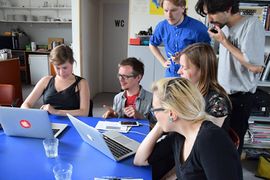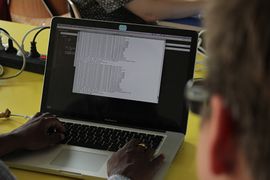Code text and text-to-speech: Difference between revisions
No edit summary |
No edit summary |
||
| (13 intermediate revisions by 4 users not shown) | |||
| Line 1: | Line 1: | ||
{{ | {{Event | ||
|Name=Code | |Name=Code text and text-to-speech | ||
|Location=De Punt, Frans de Wollantstraat 84, 1018 SC Amsterdam | |Location=De Punt, Frans de Wollantstraat 84, 1018 SC Amsterdam | ||
|Date=2015/08/01 | |Date=2015/08/01 | ||
|Time=10:00-18:00 | |Time=10:00-18:00 | ||
|PeopleOrganisations=Constant Association for Art and Media, An Mertens, Michael Murthaugh, | |PeopleOrganisations=Constant Association for Art and Media, An Mertens, Michael Murthaugh, | ||
|Type= | |Type=HDSA2015 | ||
|Web=Yes | |Web=Yes | ||
|Print=Yes | |Print=Yes | ||
}} | }} | ||
Workshop by [[An Mertens]] and [[Michael | [[File:Constant2.JPG|Code, text and text-to-speech workshop: An explaining stuff|thumb]] | ||
=== Developing chatbots for 2084 === | |||
Workshop by [[An Mertens]] and [[Michael Murtaugh]], [[Constant Association for Art and Media]] (BE). | |||
Picture this: In 2084, after the decay of Google and the deprecation of the Web 2.0 darknet, the web is reconstructed using the sustainable IRC protocol. In place of the burned-out centralized data centers created at the turn of the century, software in this new network is deployed as lightweight interogable bots in ad-hoc mesh networks and are rewritten and mutated as needed. Different bots crawl the different archives (archive.org, wikipedia, google, gitorious) and publish parts of conversation in different spaces (etherpad, wiki, print, epub). The result is a social space for writing (software, fiction, documentation) and file-sharing where software and services are as verbose as the participants. | Picture this: In 2084, after the decay of Google and the deprecation of the Web 2.0 darknet, the web is reconstructed using the sustainable IRC protocol. In place of the burned-out centralized data centers created at the turn of the century, software in this new network is deployed as lightweight interogable bots in ad-hoc mesh networks and are rewritten and mutated as needed. Different bots crawl the different archives (archive.org, wikipedia, google, gitorious) and publish parts of conversation in different spaces (etherpad, wiki, print, epub). The result is a social space for writing (software, fiction, documentation) and file-sharing where software and services are as verbose as the participants. | ||
For this workshop a basic knowledge of programming came in handy. For those familiar to Python An and Michael proposed to develop chatbots that can translate text-to-speech so we could give each of the AI personalities a personal voice. Using Free Software & Free Art Licenses only. | For this workshop a basic knowledge of programming came in handy. For those familiar to Python An and Michael proposed to develop chatbots that can translate text-to-speech so we could give each of the AI personalities a personal voice. Using Free Software & Free Art Licenses only. | ||
[ | Bot documentation can be found on [https://github.com/hackersanddesigners/HDSA2015/tree/master/bots Github] | ||
<gallery mode=packed> | |||
File:Michael-explaining.jpg | |||
File:Chatbot.jpg | |||
</gallery> | |||
Latest revision as of 13:03, 13 December 2017
| Code text and text-to-speech | |
|---|---|
| Name | Code text and text-to-speech |
| Location | De Punt, Frans de Wollantstraat 84, 1018 SC Amsterdam |
| Date | 2015/08/01 |
| Time | 10:00-18:00 |
| PeopleOrganisations | Constant Association for Art and Media, An Mertens, Michael Murthaugh |
| Type | HDSA2015 |
| Web | Yes |
| Yes | |
Developing chatbots for 2084
Workshop by An Mertens and Michael Murtaugh, Constant Association for Art and Media (BE).
Picture this: In 2084, after the decay of Google and the deprecation of the Web 2.0 darknet, the web is reconstructed using the sustainable IRC protocol. In place of the burned-out centralized data centers created at the turn of the century, software in this new network is deployed as lightweight interogable bots in ad-hoc mesh networks and are rewritten and mutated as needed. Different bots crawl the different archives (archive.org, wikipedia, google, gitorious) and publish parts of conversation in different spaces (etherpad, wiki, print, epub). The result is a social space for writing (software, fiction, documentation) and file-sharing where software and services are as verbose as the participants.
For this workshop a basic knowledge of programming came in handy. For those familiar to Python An and Michael proposed to develop chatbots that can translate text-to-speech so we could give each of the AI personalities a personal voice. Using Free Software & Free Art Licenses only.
Bot documentation can be found on Github


